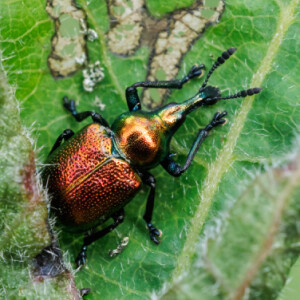Rare
After a morning practising Domestic Goddesshood (shopping taken in and put away, next week's breakfast yogurt fermenting, and an aubergine loaf made for dinner tonight), I decided that I'd earned a trip over to Trench Wood in search of insects. The drive is longer and more irritating then it should be, because the closure of Bidford Bridge necessitates setting off in the wrong direction and looping round via the Evesham bypass, but it was justified almost immediately by the two Aspen Leaf-rolling Weevils I found within a couple of hundred metres of the entrance to the wood.
Both the individuals I found were males - this being determined very easily by the presence of tiny spines on either side of the pronotum, which are only present in the male - but they looked quite different, despite the fact that they were less than a metre apart, and I photographed them in exactly the same light. You'll see what I mean if you take a look at my second photo. The Aspen Leaf-roller is described in Mark Gurney's superb on line weevil identification guides as being greenish-gold, which would make the specimen in my main photo more typical, but in fact they often appear red, or even purple, and sometimes they display an entire rainbow of iridescence.
The Aspen Leaf-rolling Weevil is one of Worcestershire's few claims to wildlife fame, because the county is one of the last remaining strongholds of a creature that has disappeared from so much of its former territory across southern England that it's now officially designated as 'Rare'. Within the Shire it can be found at Monkwood, Trench Wood and Grafton Wood, and it has also been found at Chaddesley Wood and Pepper Wood. Monkwood and Trench are especially important because the Wildlife Trust, which co-owns both sites with Butterfly Conservation, actively coppices the aspen to encourage the regrowth of young suckers. The weevil prefers young growth because it's softer and easier for the females to manipulate into the cigar-like rolls that first protect their eggs, and then act as food for the developing larvae. In this article from 2002, Jon Mellings also points out that young aspen suckers produce larger leaves than older saplings, which the female weevils appear to favour, and produce them continuously through the summer, providing a steady supply of rollable leaves throughout the weevil's breeding season.
As well as Jon Mellings' article, which is especially good on the life cycle of the Aspen Leaf-rolling Weevil, I can recommend a couple of other pieces from the Worcestershire Record, by Steve Lane (2011) and Brett Westwood (2015), if you'd like to know more about this tiny but charismatic beetle. The amount of effort being expended on finding, understanding, and preserving it gives you a sense of the almost iconic status it has achieved in the Shire.


Comments
Sign in or get an account to comment.


